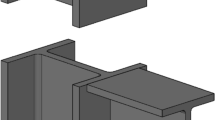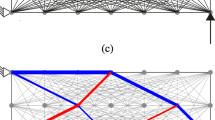Abstract
Design of real engineering structures can benefit from an optimization step in which various parameters can be determined to satisfy a given set of requirements and constraints. Optimization of spatial assemblies such as truss or frame structures involves sizing optimization to minimize the mass of the structure. Optimization of tensegrity structures is more challenging as prestress levels should be optimized as well. In this paper, sizing and prestress optimization of Class-2 tensegrity booms are addressed using a particle swarm optimization approach. Nonlinear finite-element models of tensegrity structures and solution methods provide a starting point. Furthermore, a continuum beam modeling technique for tensegrity structures with repeating units is also useful. The particle swarm optimization algorithm is described and two numerical examples are presented. The first example studies the design and single-objective optimization of a deployable Class-2 tensegrity boom with reinforcing cables to maximize the bending stiffness-to-mass ratio. The results indicate that the optimum structure is capable of competing well with the state-of-the-art deployable booms in terms of stiffness-to-mass ratio. The second example investigates a multi-objective optimization problem of a Class-2 tensegrity boom. The objective functions are selected as minimization of the mass and tip displacement, respectively. The objective functions are at least partially conflicting; therefore, Pareto-optimal solutions are obtained to guide future design decisions. The results show the potential of tensegrity structures for implementation as space structures and the robustness of the particle swarm optimization algorithm, even for multi-objective optimization problems.










Similar content being viewed by others
References
Wang B (2004) Free-standing tension structures: from tensegrity systems to cable-strut systems. Taylor and Francis Group, London
Skelton RE, de Oliveira MC (2009) Tensegrity systems, vol 1. Springer, New York
Ali NBH, Rhode-Barbarigos L, Albi AAP, Smith IF (2010) Design optimization and dynamic analysis of a tensegrity-based footbridge. Eng Struct 32(11):3650–3659
Dalilsafaei S, Eriksson A, Tibert G (2012) Improving bending stiffness of tensegrity booms. Int J Space Struct 27(2–3):117–129
Yildiz K (2018) Cable actuated tensegrity structures for deployable space booms with enhanced stiffness. PhD thesis, The Pennsylvania State University
Kebiche K, Kazi-Aoual M, Motro R (1999) Geometrical non-linear analysis of tensegrity systems. Eng Struct 21(9):864–876
Tibert A, Pellegrino S (2003) Review of form-finding methods for tensegrity structures. Int J Space Struct 18(4):209–223
Estrada GG, Bungartz HJ, Mohrdieck C (2006) Numerical form-finding of tensegrity structures. Int J Solids Struct 43(22–23):6855–6868
Tran HC, Lee J (2010) Advanced form-finding of tensegrity structures. Comput Struct 88(3–4):237–246
Tran HC, Lee J (2011) Form-finding of tensegrity structures with multiple states of self-stress. Acta Mech 222(1–2):131
Tran HC, Lee J (2013) Form-finding of tensegrity structures using double singular value decomposition. Eng Comput 29(1):71–86
De Jager B, Skelton RE (2004) Symbolic stiffness optimization of planar tensegrity structures. J Intell Mater Syst Struct 15(3):181–193
Masic M, Skelton RE (2006) Selection of prestress for optimal dynamic/control performance of tensegrity structures. Int J Solids Struct 43(7–8):2110–2125
Masic M, Skelton RE, Gill PE (2006) Optimization of tensegrity structures. Int J Solids Struct 43(16):4687–4703
Raja MG, Narayanan S (2009) Simultaneous optimization of structure and control of smart tensegrity structures. J Intell Mater Syst Struct 20(1):109–117
Lee S, Lee J (2014) Optimum self-stress design of cable-strut structures using frequency constraints. Int J Mech Sci 89:462–469
Kanno Y (2012) Topology optimization of tensegrity structures under self-weight loads. J Oper Res Soc Jpn 55(2):125–145
Kanno Y (2013) Topology optimization of tensegrity structures under compliance constraint: a mixed integer linear programming approach. Optim Eng 14(1):61–96
Marzari Q (2014) Optimization of tensegrity structures. Master’s thesis, Massachusetts Institute of Technology
Xu X, Wang Y, Luo Y, Hu D (2018) Topology optimization of tensegrity structures considering buckling constraints. J Struct Eng 144(10):04018,173
Zhang J, Ohsaki M (2007) Optimization methods for force and shape design of tensegrity structures. In: Proc 7th world congresses of structural and multidisciplinary optimization, pp 40–49
Ashwear N, Tamadapu G, Eriksson A (2016) Optimization of modular tensegrity structures for high stiffness and frequency separation requirements. Int J Solids Struct 80:297–309
Xu X, Wang Y, Luo Y (2018) An improved multi-objective topology optimization approach for tensegrity structures. Adv Struct Eng 21(1):59–70
Guest SD (2010) The stiffness of tensegrity structures. IMA J Appl Math 76(1):57–66
Nuhoglu A, Korkmaz KA (2011) A practical approach for nonlinear analysis of tensegrity systems. Eng Comput 27(4):337–345
Murakami H (2001) Static and dynamic analyses of tensegrity structures. Part 1. Nonlinear equations of motion. Int J Solids Struct 38(20):3599–3613
Tran HC, Lee J (2011) Geometric and material nonlinear analysis of tensegrity structures. Acta Mech Sin 27(6):938–949
Nishimura Y (2000) Static and dynamic analyses of tensegrity structures. PhD thesis, University of California, San Diego
Sultan C (2009) Tensegrity: 60 years of art, science, and engineering. Adv Appl Mech 43:69–145
Zhang J, Ohsaki M (2015) Tensegrity structures: form, stability, and symmetry. Springer, Tokyo
Skelton RE, Adhikari R, Pinaud JP, Chan W, Helton J (2001) An introduction to the mechanics of tensegrity structures. In: Proceedings of the 40th IEEE conference on decision and control (Cat. No. 01CH37228), IEEE, vol 5, pp 4254–4259
Noor AK, Anderson MS, Greene WH (1978) Continuum models for beam-and platelike lattice structures. AIAA J 16(12):1219–1228
Dow JO, Su Z, Feng C, Bodley C (1985) Equivalent continuum representation of structures composed of repeated elements. AIAA J 23(10):1564–1569
Kebiche K, Aoual MK, Motro R (2008) Continuum models for systems in a selfstress state. Int J Space Struct 23(2):103–115
Yildiz K, Lesieutre GA (2019) Effective beam stiffness properties of n-strut cylindrical tensegrity towers. AIAA J 57(5):2185–2194
Eberhart R, Kennedy J (1995) A new optimizer using particle swarm theory. In: MHS’95. Proceedings of the sixth international symposium on micro machine and human science, Ieee, pp 39–43
Eberhart R, Simpson P, Dobbins R (1996) Computational intelligence PC tools. Academic Press Professional, Inc, Boston, MA
Eberhart RC, Hu X (1999) Human tremor analysis using particle swarm optimization. In: Proceedings of the 1999 congress on evolutionary computation-CEC99 (Cat. No. 99TH8406), IEEE, vol 3, pp 1927–1930
Fukuyama Y, Nakanishi Y (1999) A particle swarm optimization for reactive power and voltage control considering voltage stability. In: Proc. 11th IEEE Int. Conf. Intell. Syst. Appl. Power Syst, pp 117–121
Poli R (2008) Analysis of the publications on the applications of particle swarm optimisation. J Artif Evol Appl 2008
Shi Y, Eberhart R (1998) A modified particle swarm optimizer. In: 1998 IEEE international conference on evolutionary computation proceedings. IEEE world congress on computational intelligence (Cat. No. 98TH8360), IEEE, pp 69–73
Eberhart RC, Shi Y (2000) Comparing inertia weights and constriction factors in particle swarm optimization. In: Proceedings of the 2000 congress on evolutionary computation. CEC00 (Cat. No. 00TH8512), IEEE, vol 1, pp 84–88
Coello CAC, Pulido GT, Lechuga MS (2004) Handling multiple objectives with particle swarm optimization. IEEE Trans Evol Comput 8(3):256–279
Liu H, Cai Z, Wang Y (2010) Hybridizing particle swarm optimization with differential evolution for constrained numerical and engineering optimization. Appl Soft Comput 10(2):629–640
Xia L, Cui Y, Gu X, Geng Z (2013) Kinetics modelling of ethylene cracking furnace based on sqp-cpso algorithm. Trans Inst Meas Control 35(4):531–539
Chen Y, Yan J, Sareh P, Feng J (2020) Feasible prestress modes for cable-strut structures with multiple self-stress states using particle swarm optimization. J Comput Civ Eng 34(3):04020,003
Wang B, Li Y (2003) Novel cable-strut grids made of prisms: part i. Basic theory and design. J Int Assoc Shell Spat Struct 44(2):93–108
Pinaud JP, Solari S, Skelton RE (2004) Deployment of a class 2 tensegrity boom. In: Smart structures and materials 2004: smart structures and integrated systems, international society for optics and photonics, vol 5390, pp 155–162
Masic M, Skelton RE (2004) Open-loop control of class-2 tensegrity towers. In: Smart structures and materials 2004: modeling, signal processing, and control, international society for optics and photonics, vol 5383, pp 298–308
Masic M, Skelton RE (2005) Path planning and open-loop shape control of modular tensegrity structures. J Guid Control Dyn 28(3):421–430
Guest S (2006) The stiffness of prestressed frameworks: a unifying approach. Int J Solids Struct 43(3–4):842–854
Tibert G, Pellegrino S (2003) Deployable tensegrity masts. In: 44th AIAA/ASME/ASCE/AHS/ASC structures, structural dynamics, and materials conference, p 1978
(2019) Northrop grumman astromast. http://www.northropgrumman.com/BusinessVentures/AstroAerospace/Products/Pages/AstroMast.aspx. Accessed 12 Dec 2019
Garrett HB, Pike CP (1980) Space systems and their interactions with Earth’s space environment. American Institute of Aeronautics and Astronautics
Murphey TW (2006) Booms and trusses. In: Jenkins CHM (ed) Recent advances in gossamer spacecraft (Progress in Astronautics and Aeronautics). AIAA, chap 1, pp 1–44
Tran HC, Lee J (2010) Initial self-stress design of tensegrity grid structures. Comput Struct 88(9–10):558–566
Greschik G (2007) Global imperfection-based column stability analysis. In: 48th AIAA/ASME/ASCE/AHS/ASC structures, structural dynamics, and materials conference, p 2225
Cui Y, Geng Z, Zhu Q, Han Y (2017) Multi-objective optimization methods and application in energy saving. Energy 125:681–704
Haimes YY, Lasdon LS, Da Wismer D (1971) On a bicriterion formation of the problems of integrated system identification and system optimization. IEEE Trans Syst Man Cybern 1(3):296–297
Author information
Authors and Affiliations
Corresponding author
Additional information
Publisher's Note
Springer Nature remains neutral with regard to jurisdictional claims in published maps and institutional affiliations.
Rights and permissions
About this article
Cite this article
Yildiz, K., Lesieutre, G.A. Sizing and prestress optimization of Class-2 tensegrity structures for space boom applications. Engineering with Computers 38, 1451–1464 (2022). https://doi.org/10.1007/s00366-020-01111-x
Received:
Accepted:
Published:
Issue Date:
DOI: https://doi.org/10.1007/s00366-020-01111-x




